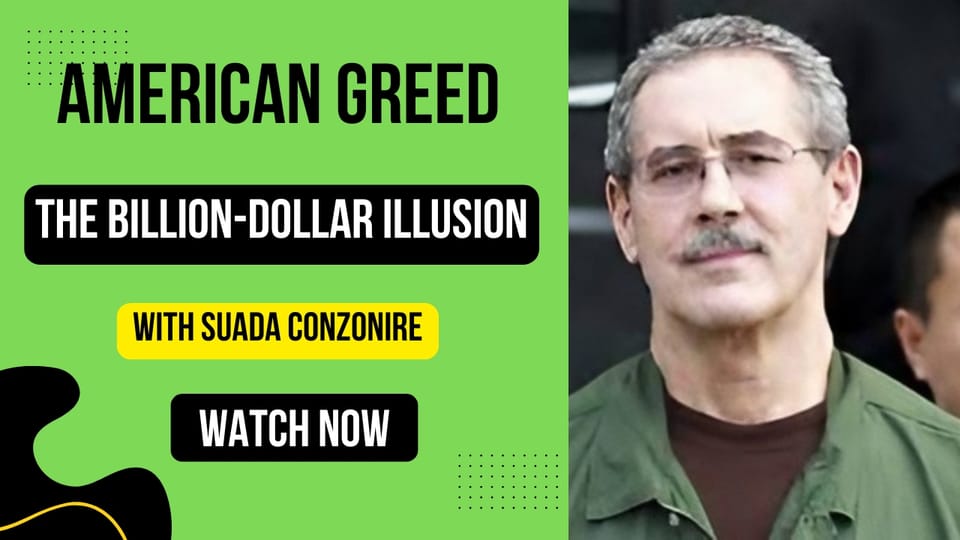The Billion-Dollar Illusion: Allen Stanford's Empire of Lies

When you hear the word “Ponzi scheme,” you probably think of Bernie Madoff — Wall Street boardrooms, New York offices, pinstripe suits. But what if we told you one of the biggest financial frauds in U.S. history was orchestrated from a sun-soaked Caribbean island, by a man in a white suit who loved cricket more than stocks?
Meet Allen Stanford: the self-proclaimed billionaire banker who fooled the world, charmed governments, and stole over $7 billion from investors across the globe. His empire was built on fantasy, and when it crumbled, thousands were left picking up the pieces of a dream they never thought could be fake.
In this episode of Suada’s Crime Files, we dive into “The Billion-Dollar Illusion,” unraveling how Allen Stanford pulled off one of the most brazen white-collar crimes America has ever seen. This case is also part of our American Greed series — the special edition of Suada’s Crime Files that focuses on white-collar crimes in the U.S. or those targeting U.S. citizens.
Who Was Allen Stanford?
Allen Stanford wasn’t born into wealth. After graduating from Baylor University in Waco, Texas, he worked in real estate and insurance before venturing into offshore banking — a world he would later exploit on an unprecedented scale. By the mid-1990s, Stanford had established Stanford International Bank (SIB) on the island of Antigua. From there, his wealth, power, and influence exploded — or so it seemed.
He claimed to be a billionaire. He traveled by private jet, donated millions to political campaigns, and was even knighted by the Antiguan government. He created his own cricket league and presented massive checks at matches broadcast worldwide. The media couldn’t get enough of him.
But behind the flash and façade, the truth was far more sinister.
The Mechanics of the Fraud
Stanford’s primary pitch? Certificates of Deposit (CDs) that promised unusually high returns — often double or triple what U.S. banks could offer. He claimed the money was invested in safe, liquid assets. In reality, much of it was either never invested at all or funneled into high-risk ventures, luxury lifestyles, and to pay off earlier investors — the hallmark of a classic Ponzi scheme.
He marketed these CDs with flashy brochures, promises of confidentiality, and the reassurance of his own supposed financial genius. Thousands of investors — from retirees to small business owners to wealthy elites — entrusted him with their money.
By the early 2000s, the SEC had already begun receiving warnings. Whistleblowers raised alarms. Financial analysts scratched their heads at the “too good to be true” numbers. But Stanford’s operation was smooth, aggressive, and cloaked in legitimacy. It took years before regulators made a move.
The Collapse
The financial crisis of 2008 was the final straw. As markets fell and investors began requesting redemptions, the money simply wasn’t there. In February 2009, the U.S. Securities and Exchange Commission (SEC) charged Stanford with running a massive Ponzi scheme. Just months later, he was arrested in Virginia.
The trial revealed shocking details — falsified documents, bribes, and the manipulation of offshore regulators. In 2012, Stanford was convicted on 13 out of 14 counts including wire fraud, mail fraud, and obstruction of justice. He was sentenced to 110 years in federal prison.
The Aftermath
Stanford’s victims numbered in the tens of thousands. Retirees lost their nest eggs. Families lost homes, futures, and peace of mind. Some would never recover financially or emotionally.
Unlike Madoff’s case, which was largely confined to the U.S., Stanford’s fraud had a global reach. Victims came from over 100 countries, making it one of the most far-reaching financial scams ever prosecuted in America.
Today, Stanford sits in a high-security prison, still proclaiming his innocence. But for those affected, the damage is irreversible.
What Makes This Case So Important?
Stanford’s story isn’t just about greed. It’s about the seductive power of image — how luxury, confidence, and connections can make the unbelievable feel safe. He wore the mask of a legitimate banker, and for years, no one dared question it.
In Suada’s Crime Files: American Greed, we explore cases just like this — crimes committed not with guns or violence, but with charm, spreadsheets, and white-collar deception that ruins lives all the same.
Watch or Listen to the Full Episode
Want to hear the full breakdown of how Allen Stanford built his empire of lies — and how it all came crashing down?
🎥 Watch the full episode on YouTube
🎧 Listen now on Spotify
📬 Never miss an episode.
Sign up for Suada’s newsletter at suadaconzonire.com to get the latest true crime stories, podcast drops, and exclusive updates straight to your inbox. Whether it’s white-collar fraud or gripping criminal cases, you’ll be the first to know when new episodes go live.
Member discussion